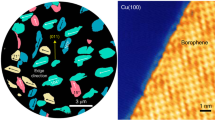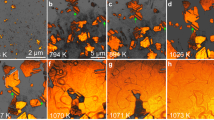Abstract
Borophene, a theoretically proposed two-dimensional (2D) boron allotrope1,2,3, has attracted much attention4,5 as a candidate material platform for high-speed, transparent and flexible electronics6,7,8,9. It was recently synthesized, on Ag(111) substrates10,11, and studied by tunnelling and electron spectroscopy12. However, the exact crystal structure is still controversial, the nanometre-size single-crystal domains produced so far are too small for device fabrication and the structural tunability via substrate-dependent epitaxy is yet to be proven. We report on the synthesis of borophene monitored in situ by low-energy electron microscopy, diffraction and scanning tunnelling microscopy (STM) and modelled by ab initio theory. We resolved the crystal structure and phase diagram of borophene on Ag(111), but found that the domains remain nanoscale for all growth conditions. However, by growing borophene on Cu(111) surfaces, we obtained large single-crystal domains, up to 100 μm2 in size. The crystal structure is a novel triangular network with a concentration of hexagonal vacancies of η = 1/5. Our experimental data, together with first principles calculations, indicate charge-transfer coupling to the substrate without significant covalent bonding. Our work sets the stage for fabricating borophene-based devices and substantiates the idea of borophene as a model for development of artificial 2D materials.
This is a preview of subscription content, access via your institution
Access options
Access Nature and 54 other Nature Portfolio journals
Get Nature+, our best-value online-access subscription
$29.99 / 30 days
cancel any time
Subscribe to this journal
Receive 12 print issues and online access
$259.00 per year
only $21.58 per issue
Buy this article
- Purchase on Springer Link
- Instant access to full article PDF
Prices may be subject to local taxes which are calculated during checkout





Similar content being viewed by others
Data availability
All the data generated and analysed during this study are included within this paper and the associated Supplementary Information.
Change history
14 December 2018
The links to the Supplementary Video files were missing; they have now been included.
References
Tang, H. & Ismail-Beigi, S. Novel precursors for boron nanotubes: the competition of two-center and three center bonding in boron sheets. Phys. Rev. Lett. 99, 115501 (2007).
Yang, X., Ding, Y. & Ni, J. Ab initio prediction of stable boron sheets and boron nanotubes: structure, stability and electronic properties. Phys. Rev. B 77, 041402(R) (2008).
Tang, H. & Ismail-Beigi, S. Self-doping in boron sheets from first principles: a route to structural design of metal boride nanostructures. Phys. Rev. B 80, 134113 (2009).
Mannix, A. J., Kiraly, B., Hersam, M. C. & Guisinger, N. P. Synthesis and chemistry of elemental 2D materials. Nat. Rev. Chem 1, 0014 (2017).
Mannix, A. J., Zhang, Z., Guisinger, N. P., Yakobson, B. I. & Hersam, M. C. Borophene as a prototype for synthetic 2D materials development. Nat. Nanotech. 13, 444–450 (2018).
Zhang, Z. H., Penev, E. S. & Yakobson, B. I. Polyphony in B flat. Nat. Chem. 8, 525–527 (2016).
Penev, E. S., Bhowmick, S., Sadrzadeh, A. & Yakobson, B. I. Polymorphism of two-dimensional boron. Nano Lett. 12, 2441–2445 (2012).
Wu, X. et al. Two-dimensional boron monolayer sheets. ACS Nano 6, 7443–7453 (2012).
Zhang, Z., Yang, Y., Penev, E. S. & Yakobson, B. I. Elasticity, flexibility and ideal strength of borophenes. Adv. Func. Mat. 27, 1605059 (2017).
Mannix, A. J. et al. Synthesis of borophenes: anisotropic, two-dimensional boron polymorphs. Science 350, 1513–1516 (2015).
Feng, B. et al. Experimental realization of two-dimensional boron sheets. Nat. Chem. 8, 563–568 (2016).
Feng, B. J. et al. Direct evidence of metallic bands in a monolayer boron sheet. Phys. Rev. B 94, 041408 (2016).
Zhang, Z. H., Yang, Y., Gao, G. Y. & Yakobson, B. I. Two-dimensional boron monolayers mediated by metal substrates. Angew. Chem. Int. Ed. 54, 13022–13026 (2015).
Penev, E. S., Kutana, A. & Yakobson, B. I. Can two-dimensional boron superconduct? Nano Lett. 16, 2522–2526 (2016).
Feng, B. et al. Dirac fermions in borophene. Phys. Rev. Lett. 118, 096401 (2017).
Volovik, G. E. From standard model of particle physics to room-temperature superconductivity. Phys. Scr. T164, 014014 (2015).
Bauer, E. Low energy electron microscopy. Rep. Progr. Phys. 57, 895–938 (1994).
Hannon, J. B. & Tromp, R. M. Low-energy microscopy of surface phase transitions. Annu. Rev. Mater. Res. 33, 263 (2003).
Suter, P., Sadowski, J. T. & Sutter, E. Graphene on Pt(111): growth and substrate interaction. Phys. Rev. B 80, 245411 (2009).
Altman, M. S. Trends in low energy electron microscopy. J. Phys. Condens. Matter 22, 084017 (2010).
Giessibl, F. J. High-speed force sensor for force microscopy and profilometry utilizing a quartz tuning fork. Appl. Phys. Lett. 73, 3956–3958 (1998).
Gross, L. et al. High-resolution molecular orbital imaging using a p-wave STM tip. Phys. Rev. Lett. 107, 086101 (2011).
Hapala, P. et al. Mechanism of high resolution STM/AFM imaging with functionalized tips. Phys. Rev. B 90, 085421 (2014).
Gianozzi, P. et al. Quantum Espresso: a modular and open source software project for quantum simulations of materials. J. Phys. Condens. Matter 21, 395502 (2009).
Tersoff, J. & Hamann, D. R. Theory and application for the scanning tunneling microscope. Phys. Rev. Lett. 50, 1998 (1983).
Chen, C. J. Tunneling matrix elements in three dimensional space: the derivative rule and the sum rule. Phys. Rev. B 42, 8841 (1990).
Liu, H. S., Gao, J. F. & Zhao, J. J. From boron cluster to two-dimensional boron sheet on Cu(111) surface: growth mechanism and hole formation. Sci. Rep. 3, 3238 (2013).
Galeev, T. R. et al. Deciphering the mystery of hexagon holes in an all boron graphene α-sheet. Phys. Chem. Chem. Phys. 13, 11575–11578 (2011).
Zhang, Z. et al. Substrate induced nanoscale undulations of borophene on silver. Nano Lett. 16, 6622–6627 (2016).
Liu, X., Zhang, Z., Wang, L., Yakobson, B. I. & Hersam, M. C. Intermixing and periodic self-assembly of borophene line defects. Nat. Mater. 17, 783–788 (2018).
Acknowledgements
This research was supported by the US Department of Energy, Basic Energy Sciences, Materials Sciences and Engineering Division. R.W. and A.G. are supported by the Gordon and Betty Moore Foundation’s EPiQS Initiative through grant GBMF4410. I.K.D. acknowledges the support of a BNL Gertrude and Maurice Goldhaber Distinguished Fellowship. This research used resources of the Center for Functional Nanomaterials, which is a US DOE Office of Science Facility, at Brookhaven National Laboratory under contract no. DE-SC0012704. S.E. is supported by the National Science Foundation Graduate Research Fellowship through grant DGE-1122492. S.E and S.I.-B. thank the computing resources provided by the staff of the Yale University Faculty of Arts and Sciences High Performance Computing Center as well as NSF XSEDE resources via grant TG-MCA08X007.
Author information
Authors and Affiliations
Contributions
R.W. took and analysed the experimental LEEM, LEED, XPS and AFM data with help from A.G. I.K.D. and P.Z. acquired the low-temperature STM data and analysed them with help from R.W. and A.G., S.E. and S.I.-B. performed the ab initio calculations and analysed the results. I.B. conceived and supervised the project. A.G. wrote the manuscript with contributions from all the authors.
Corresponding author
Ethics declarations
Competing interests
The authors declare no competing interests.
Additional information
Publisher’s note: Springer Nature remains neutral with regard to jurisdictional claims in published maps and institutional affiliations.
Supplementary information
Supplementary Video 1
B-Cu111 Film growth
Supplementary Video 2
B-Cu111 Faceted islands
Supplementary Video 3
B-Cu111 Miscibility
Rights and permissions
About this article
Cite this article
Wu, R., Drozdov, I.K., Eltinge, S. et al. Large-area single-crystal sheets of borophene on Cu(111) surfaces. Nature Nanotech 14, 44–49 (2019). https://doi.org/10.1038/s41565-018-0317-6
Received:
Accepted:
Published:
Issue Date:
DOI: https://doi.org/10.1038/s41565-018-0317-6
This article is cited by
-
Realization of large-area ultraflat chiral blue phosphorene
Nature Communications (2024)
-
Epitaxial growth of borophene on graphene surface towards efficient and broadband photodetector
Nano Research (2024)
-
Experimental evidence of surface copper boride
Nano Research (2023)
-
A Review on Borophene: A Potential Gas-Capture Material
Journal of Electronic Materials (2023)
-
Borophene-ZnO heterostructures: Preparation and application as broadband photonic nonvolatile memory
Nano Research (2023)



